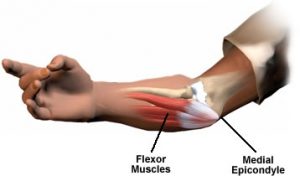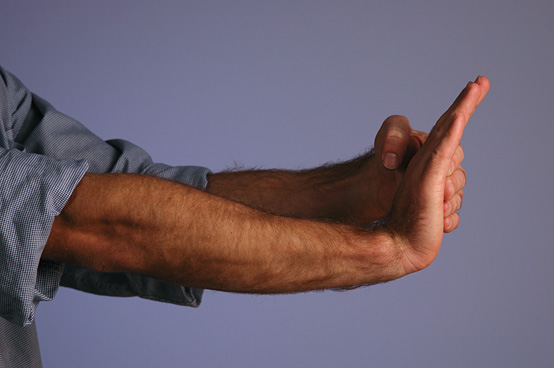The elbow is a complex joint that is often asked to perform repetitive tasks under significant stress. The elbow is made up of the distal end of the humerus and the proximal ends of the ulna and radius. Muscles that cross the elbow allow us to flex and bend the elbow as well as perform many of the motions of our hands. This includes flexion and extension and the turning motion of the wrist and hand.
If pain is located along the inside of the elbow, this is often due to medial epicondylitis. Pain along the lateral aspect of the elbow is most commonly lateral epicondylitis. Pain with swelling in the back of the elbow may be due to olecrenon bursitis. People that perform a throwing motion are vulnerable to a host of sport-specific elbow injuries that must be evaluated carefully. Children and adolescents are especially vulnerable secondary to the fact that they are growing and have open growth plates.
What is medial epicondylitis?
 Medial epicondylitisMedial epicondylitis is also referred to as “golfer’s elbow.” The muscles that are used to pull the hand down, the wrist flexors, are located on the palm side of the forearm. These muscles join together and attach to the common flexor tendon, which attaches to the medial epicondyle (the inside of the elbow.) When the wrist flexors are overused, the common flexor tendon becomes inflamed and painful.
Medial epicondylitisMedial epicondylitis is also referred to as “golfer’s elbow.” The muscles that are used to pull the hand down, the wrist flexors, are located on the palm side of the forearm. These muscles join together and attach to the common flexor tendon, which attaches to the medial epicondyle (the inside of the elbow.) When the wrist flexors are overused, the common flexor tendon becomes inflamed and painful.
Pain on the inside of the elbow, usually during or after intense use, usually indicates medial epicondylitis. Because people who play golf sometimes develop this problem, it has become known as “golfer’s elbow.”
What causes medial epicondylitis?
Overuse of the wrist extensors can create cumulative stress on the tendon. The excessive stress may damage the muscle attachment and cause inflammation and pain. As the tendon tries to repair itself, scar tissue may form. Some physicians believe that a lack of blood flow to the aging tendons make them weak and prone to injury.
Pain at the medial epicondyle signals medial epicondylitis. The pain will increase when flexing the wrist, and may radiate down the forearm. Activities that use the flexor muscles in a bending motion or grasping with the hand can increase the symptoms.
What is the treatment for medial epicondylitis?
Discontinuing activities that cause the pain is the first step toward proper treatment of medial epicondylitis. Icing the elbow for 10-15 minutes at a time will decrease the inflammation and swelling and relieve pain. In some cases, a wrist splint may be recommended. Anti-inflammatory medication may help reduce inflammation and pain. In chronic or intense cases, a steroid injection may relieve the discomfort.
Exercises that stretch and strengthen the muscles will help prevent the condition from returning. Recurrence of this condition is common, and return to activity should not take place too quickly.
If nonsurgical forms of treatment do not eliminate the pain associated with this condition, surgery may be recommended. Medial epicondylitis is often a nagging or chronic condition, sometimes requiring many months for healing to occur.

